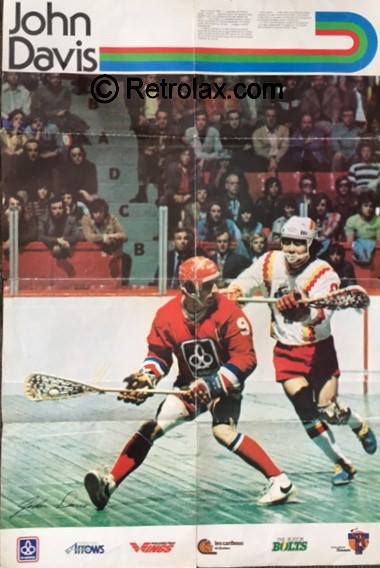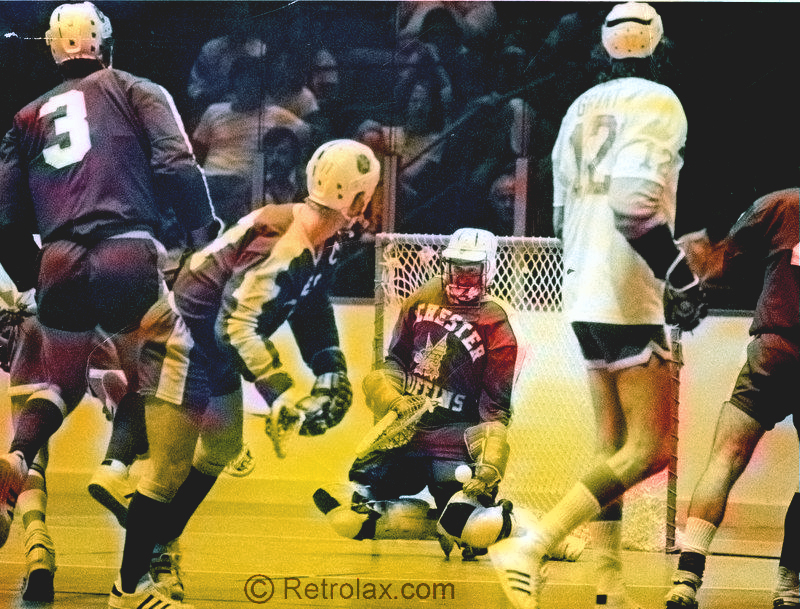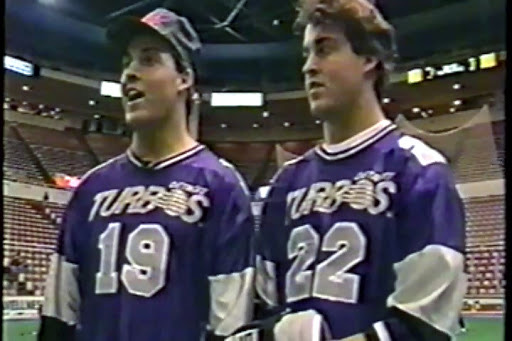No one is more jealous of Les Quebecois than their rivals of the Capital Center, the Maryland Arrows.
Les Quebecois succeeded in convincing all of their players except two, Ernie Mitchell and Ron Liscombe to move to Montreal, which is quite an achievement when one realizes that the salaries in the National Lacrosse League are not yet that high and that Les Quebecois have not less than ten players who normally reside in the far away province of British Columbia.
John Ferguson and Nelson Stoll, used their collective grey matters and came across a brilliant idea in organizational genius in deciding to group as many players as possible in Montreal. Even though it entailed numerous telephone calls across the country, speaking to as many individual players as possible before the draft.
Today Les Quebecois form a very closely knit family in Montreal. In this way all the players are available for practices and certain players can also be used for promotional schemes. Most important of all is the fact that with so many players gathered in one home base, it means less travelling for them.

Maryland is far from Toronto
When you look at the league schedule you would say that each team has twenty games away from home. Yes and no. Yes in the terms of the schedule. No in the case of the Arrows, with the great majority of players residing in Ontario and choosing to travel.
“It’s a big problem”, explains coach Paul Clancey. “Not only do our players play the regular amount of away games in cities such as Philadelphia, Syracuse, Rochester and Montreal, but of course we have our own home games which amount to twenty. These home games, from Toronto to Washington, are the trips that tire us the most.
“Take for example one player who lives in Sarnia, Ontario. On the day of a game he may have to catch his plane at two o’clock in the afternoon, thus he would have to leave his home for the Toronto Airport at about 11 o’clock in the morning.
“The plane takes two hours and 40 minutes to reach Washington. This player would not return to Toronto before two o’clock in the morning, and then he has approximatively 100 miles to drive before he sees his home. It is a system that demands much from the individual from a physical standpoint.”
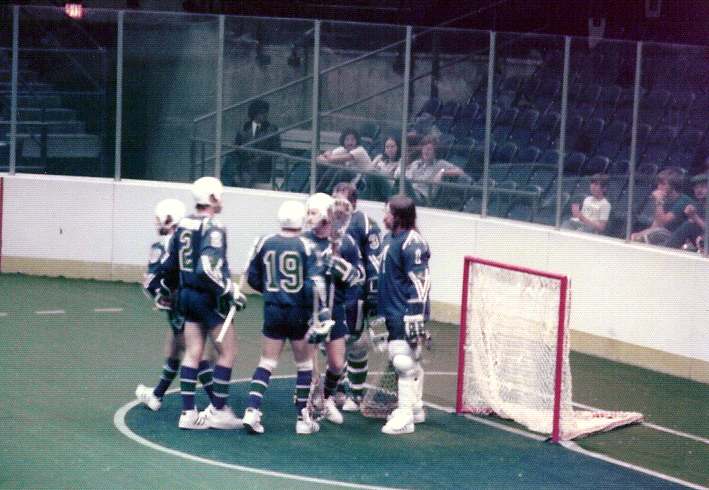
Will the league understand the Arrows?
There is more to solving a problem than just identifying it. It is well recognized by the Arrows and their management that it would be easier for their players to group them in Washington, but it is also recognized that this is a “brain bending” problem.
The Arrows management didn’t realize at the draft session that their Arrows would have to live in Washington one day, and thus the players were not picked accordingly. The players did not know either.
The team trained in Oshawa, a suburb of Toronto, which was convenient for everyone, and the Arrows arranged for their personal business affairs (travelling to different league cities) out of Toronto. Suddenly, the players came to understand that they would have to leave everything until next September, their homes, jobs, and in certain cases their families.
“We polled our players, said Clancey, and at least 70% feel the way we do, that they must move to Washington. But there are those who stand to lose a lot if we do make the move. Some of our players have important jobs in On-tario and it would be very difficult “deed for us to find them equivalent jobs in Washington. Not in the two or three weeks that we would have to do it in. We will have to compensate, give them extra money in exchange for their move. And we are ready to do it if the league agrees.
You know that the league salaries are fixed and frozen in the National Lacrosse League this year. It is forbidden for teams to give cost-of-living bonuses to their players.
The problem remains urgent and there is no other way to settle it. So we will plead our case in front of the executive committee and the league board of governors.

The Arrows have the Montreal vote
We must expect that the Arrows will obtain the permission they are hoping for. In any case they can rely on the Montreal vote. When we explained their problem to lohn Ferguson he didn’t hesitate one moment to declare that the Arrows situation was critical and that no one would benefit if the Maryland franchise was to falter and finally fall.
“I was one of the first to advise them to gather all their players in Washington. I know by experience that Les Quebecois profit enormously from the fact that they live in Montreal. And I can also understand that by making those twenty trips from Toronto to Washington and all the other “away” games, life must be quite impossible for them! In any case the Arrows will not go against the spirit of the rule if the League allows them to give special bonuses.
“They will not use this money to try and obtain players from other teams who may quit their original teams to play for Washington and receive higher salaries. The Arrows are only interested in their own players. By residing in Washington as a home base and saving physical energy, they would thus afford the League stronger opposition. They have my vote.”
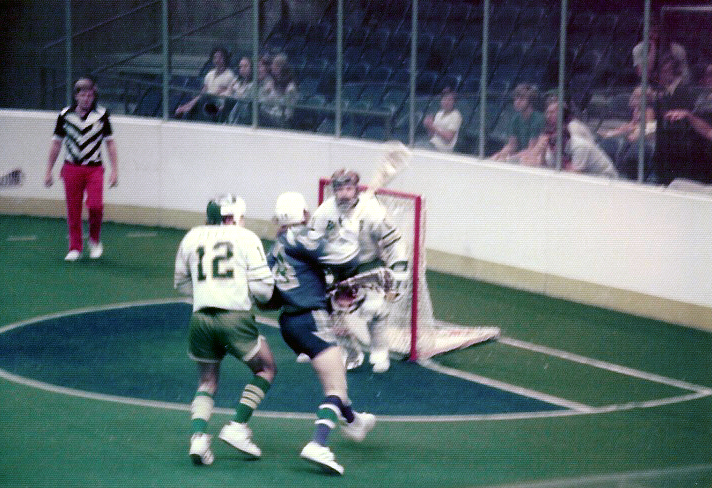
Off to a strong start … then fatigue sets in!
There can be little doubt that with all the travelling that the Arrows do, what with rushing here and there, rushing to catch a plane, hurrying for practice, getting back to Toronto late at night, (or early in the morning) that fatigue is bound to take its toll. The Arrows began the season like hungry lions although a temporary coach directed their training camp. A temporary coach whom, strange as it may seem knew very little about box lacrosse.
Paul Clancey did not arrive on the scene before the end of April, replacing the actual general-manager Bud Beardmore. Beardmore who managed the drafting for the Arrows in March, is the chief coach for the University of Maryland lacrosse team, and it’s a good thing that Beardmore was there when the Arrows needed a temporary coach during training camp. Clancey agrees that they owe a lot to him.
The beginning of the season was very successful for the Arrows. They came out and defeated the powerful Philadelphia Wings by the score of 17 to 14 in their first game, and followed up with more impressive victories, such as completely demoralizing the Syracuse Stingers three matches in a row, and then walking over the Rochester Griffins 22 to 13. Only the Toronto Tomahawks were able to stop the Arrows in the Arrows first six games, and this by the close score of 18 to 15. Then the fatigue that we talked of earlier began to show on the faces of the Arrows and in the way they played.
Les Quebecois simply out-played them at the Capital Center and defeated them 14 to 8. Then Toronto again came out on top of a 22 to 15 score. The Arrows wanted a good rest but first they had to play the Griffins of Rochester, and the Griffins embarrassed them with a score of 21 to 10.

The Stars: Paul Suggate, Coghill, Coombes, Henderson
We have to agree with the philosophy of the Arrows management, when they say that they must group their players in Washington. We must also agree with John Ferguson to vote for them when the matter of extra money comes before the governors of the league.
The Arrows are a much better team than their record in the last few games indicates, and it is important that everyone contributes so that their stars may start to produce again. In fact they have quite a star in the person of Mr. Paul Suggate, their first choice in the draft, and Jim Bishop for one, coach of the Tomahawks, made no secret about it at that draft, that he considered Suggate one of the best players available today.
The Maryland management preferred Suggate to Chuck Li, Bill Foote, Dale McKenzie, Gaylord Powless, and Dave Litzenberger. Must we say more?
Suggate is one of the more complete players of the league. Fundamentally a defenceman, he leads the list of scorers on the Arrows team. And he does not like to lose. At 25 years of age he stands six feet tall and weights 190 pounds. Lacrosse people started talking about him in 1970 when he wore the colours of the Lakeshore Maple Leafs, the Junior Champions of Canada. The next year 1971, he was with the Brantford Warriors, the Canadian Senior Champions! He is fast, an extremely hard checker and an excellent scorer.
Suggate plays on the Arrows first line with Vic Generoux and former teammates Brian Coghill (second round draft choice) and the brothers John and Jerry McKenna. The veteran Cy Coombes, Gord Keates, Wayne Granger, Ken Henderson and Tom Vann form the second line for Maryland.
Watch them tonight; see Suggate control the play from one end to the other. Watch Coghill (a master of setting up plays) feed his mates on the power play, and Henderson standing to the right of Les Quebecois goaler and letting loose one of his famous shots.

There are no better in Lacrosse!
And if by chance you are in Maryland this summer do yourself a favour. Visit the Capital Center, the home of the Arrows. This new arena, as large as the Forum in Montreal, has already become quite famous. Among other things it features four huge screens on all sides of the large scoreboard, (each screen measures 12′ x 12′) where you can see the instant replays of all the exciting action.
Suggate, Coghill, Henderson, the Capital Center, when you think of it, lacrosse would not be the same without them. Let’s wish them luck when they bring their cause before the executive committee and league governors.


